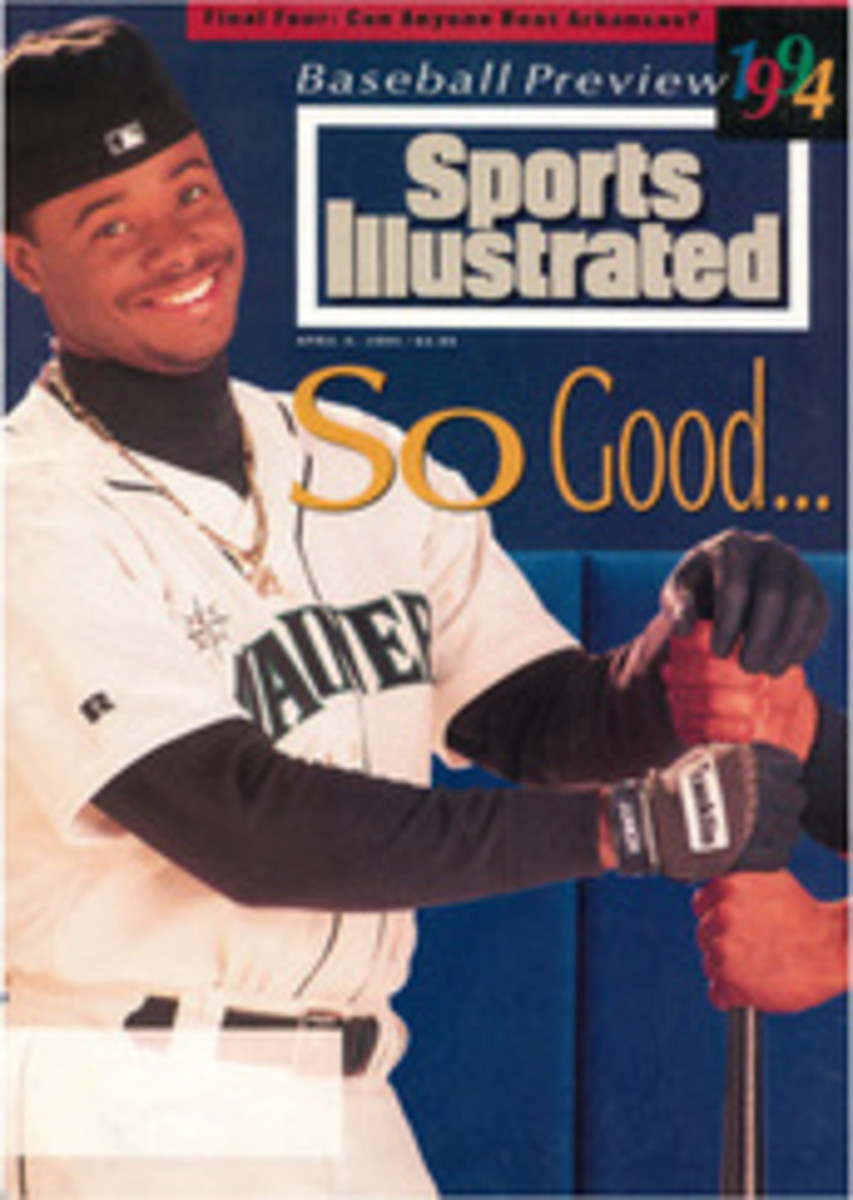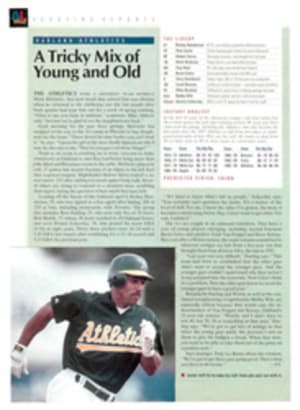
Belting the Champions
The only clue to the treasure buried in the basement of Phil Valentino's place in Weehawken, N.J., is a sepia print that hangs by the cellar door. John L. Sullivan, the last bare-knuckle heavyweight champion of the world, his brawny arms folded across his chest, a determined frown framed by his drooping handlebar mustache, glares defiantly at all who dare pass his way.
The three-story, white-stucco house doesn't belong to a fighter. But on display in Valentino's cramped, stuffy basement—barely bigger than a boxing ring—is an impressive cache of something every fighter covets: championship belts.
"Sure they're gaudy," says the senior Valentino, a smile lifting the edges of his gray mustache. "They have to be. People have to see them up in the cheap seats."
Valentino, who works with his 40-year-old son, Phil Jr., doesn't make all the belts, but his company, Phil Valentino Originals, does make the IBF, WBA, WBO, WBF, IBC (and just about any other three letters you can throw together) championship belts. He also makes The Ring magazine's Fighter of the Year belt, the North American Boxing Federation Championship belt, various state championship belts and an occasional wrestling belt. He even made the Potamkin Athlete of the Year belt, an award the automobile company used to present to athletes in a variety of sports and one that looks like a hubcap sitting on a leather strap.
"I've done some other things. Necklaces for Tiffany. Some trophies, statues and plaques," says the 64-year-old Valentino. "And this," he says, waving a bill of sale for $2,500, "a collar for Schottzie. You know. The dog." (When the Cincinnati Reds won the World Series in 1990, the company that made the team's championship rings asked Valentino to make a dog collar in the style of a ring for Schottzie, owner Marge Schott's Saint Bernard.)
But it is as a designer for pugs that Valentino has made his mark. Opening a black hard-shell carrying case, he takes out a belt he designed for the WBA. Like most others, it is made from thick, latigo leather carefully stitched and mounted with a 24-karat-gold-plated pewter centerpiece. There are two blank side plates that fighters usually have engraved with the results of their bouts. And those brilliant gems you can see even from the cheap seats? They're actually Austrian crystal. "The best crystal there is," Valentino insists.
If crystal seems a bit cheap for a champ, don't blame the old jewelry maker. The various boxing organizations get what they pay for, and they pay $650 per belt.
Such budgetary concerns are a far cry from the days of John L. Although the first championship "belt"—a regal construction of lionskin and sterling silver—was awarded to English bare-knuckler Tom Cribb by King George III in 1811, Sullivan's era was literally the golden age of belts.
And yet, even in his time, chaos reigned in boxing. The Boston Strong Boy, as Sullivan was called, competed for several championship titles. After Sullivan battered Jake Kilrain in the last American bare-knuckle title fight, which took place in Richburg, Miss., on July 8, 1889, Police Gazette publisher Richard K. Fox reportedly climbed through the ropes to present the champion with a $5,000 belt he had previously given to Kilrain. Sullivan, who loathed Fox, is said to have spat at it.
"Get that damned dog collar out of here," bellowed the Great John L. Hence, Fox's belt, which was made in 1884, was known ever after as "the dog collar."
Two years earlier, when Fox had presented that belt to Kilrain in anticipation of a bout that never took place, Sullivan's hometown fans were so outraged that they raised $8,000 and gave their fighter a belt of his own. Known as the Sullivan-Boston belt, it was made from 80 ounces of 12-karat gold. The massive centerplate read: PRESENTED TO THE CHAMPION OF CHAMPIONS, JOHN L. SULLIVAN, BY THE PEOPLE OF THE UNITED STATES, spelled out in 397 diamonds.
It was Sullivan's to keep forever, but his fiercest adversary, alcohol, forced him to leave it in pawnshops countless times. "John L. hocked the belt seven times in New York alone." said William Muldoon, a famous wrestler who once redeemed it for Sullivan.
When Sullivan died in 1918, the whereabouts of his belt were a mystery. Finally, in 1926, Nat Fleischer, then editor of The Ring, read in a newspaper that the belt was in the hands of a junk dealer in Baltimore. All the gems were gone, but the gold shell was still intact. Fleischer wrote in his 1951 book, John L. Sullivan, that despite his best efforts to buy the belt, the junkman sold it to the U.S. Mint in Philadelphia. According to Fleischer, the Sullivan-Boston belt, a priceless piece of boxing history, was melted down after its owner had been paid its value in gold—$812.
When James J. Corbett knocked out Sullivan in 1892, he gladly accepted "the dog collar" that Sullivan had spurned. Corbett took the belt with him on a vaudeville tour in 1893. While in Indianapolis, he left it on display in a shop window. During the night the belt was stolen and was never recovered.
For the next three decades champions usually received belts only if their fans could raise the money to provide them with one. That changed in 1926 when The Ring began presenting its own championship belts. For decades the magazine had been considered the authority in rating fighters—it continues to rate them today, of course—and its belts were regarded as the authentic tributes. Jack Dempsey was awarded the first of the Ring belts in recognition of his great career.
The magazine's belts were made of silver plates mounted on red, white and blue satin. "They weren't worth very much," says Stanley Weston, who wrote for The Ring during the Fleischer era, left in the '50s and returned to the magazine in the late '80s as its publisher. "They usually cost about $250."
Fleischer believed champions should receive belts. But Valentino says he understands that during Fleischer's reign there were occasions when the magazine didn't present fighters with belts immediately after their bouts. Henry Armstrong, who held three world titles in three different weight divisions simultaneously during the 1930s, was one fighter who may have had to wait for his belts.
Weston says he recalls that Armstrong was indeed presented with his belts, but in any case, Valentino was asked by The Ring in the early '70s to make three new ones for the long-retired fighter. And it was then that Valentino came into the decidedly murky picture.
"A friend of mine brought me up to see Nat Loubet [then managing editor of The Ring]," Valentino recalls. "He had heard the old man who was making their belts was retiring, so Loubet asked to see me."
Valentino was an obvious choice. While running his jewelry-making business, he was managing fighters—albeit unsuccessfully—on the side. Loubet showed Valentino the Ring belts, and the jeweler set about making the three for Armstrong. Valentino's work pleased Loubet and landed him the account. From then on things snowballed. In the mid-70s Bob Lee, vice president of the WBA, gave Valentino his organization's belt business, and when Lee jumped to the IBF in the mid-'80s. he again called upon Valentino. Along the way various state commissions weighed in with their requests.
The apparently never-ending spontaneous generation of governing bodies may trouble boxing fans who long to have one champion in each division, but it doesn't bother Valentino.
"I think it's good for the fighters and the fans," Valentino says. "They get more interesting bouts because they're title bouts." Of course, he profits from boxing's fractiousness; more champions mean more belts.
Bert Randolph Sugar, the editor of Boxing Illustrated (a monthly magazine) and the sport's unrelenting gadfly, advocate, huckster and king of one-liners, disagrees. He wants a return to the days of eight champions in eight divisions. And he doesn't think much of today's belts.
"They look like they were made out of broken beer bottles from the San Diego Freeway," Sugar says. "They have fallen into the same trash heap as the sport."
Sugar believes fighters are getting shortchanged on everything—beginning and ending with belts. So during his stint in the late 1970s and early '80s as editor of The Ring, he began presenting $5,000 belts. Several were awarded until, as Sugar says, "I ran $5,000 short."
Sugar's belts were underwritten by Seagram's V.O. as part of an advertising campaign for the liquor. When the company decided the campaign had run its course, it decided to stop awarding the belts.
Even Sugar admits that the dollar value of the belts isn't the factor that it used to be. "Now you have a new element in play," he says. "It's no longer gem weight; it's collector weight."
And belts are hot items among collectors. Jack Dempsey's Ring belt was bought for $25,000 at an auction in July 1992, and the one presented to Joe Louis brought $100,000 at auction in 1991.
Collectors have even made their way to Valentino's doorstep. He frequently gets calls from fans who want to buy a belt, and while he will make half-scale versions, the real things are only for champions who have earned them. "Fans, they can't get one," Valentino says. "Only the sanctioning bodies can buy a belt. The World Boxing Association belt belongs to the World Boxing Association, as far as I'm concerned. I don't have one. My friends don't have one. Only the organizations have them."
But he is aware that collectors are adding to the reputation and value of his work. "Sure, I get a certain pride," Valentino says. "I know these belts will still be around long after I'm pushing up daisies."
PHOTO
MANNY MILLAN
Valentino, surrounded by his flashy designs, reflects on John L.
PHOTO
MANNY MILLAN
Lords of "The Ring": Fleischer banded Sonny Liston in '63; Louis earned his belt many times over.
PHOTO
THE RING MAGAZINE
[See caption above.]

